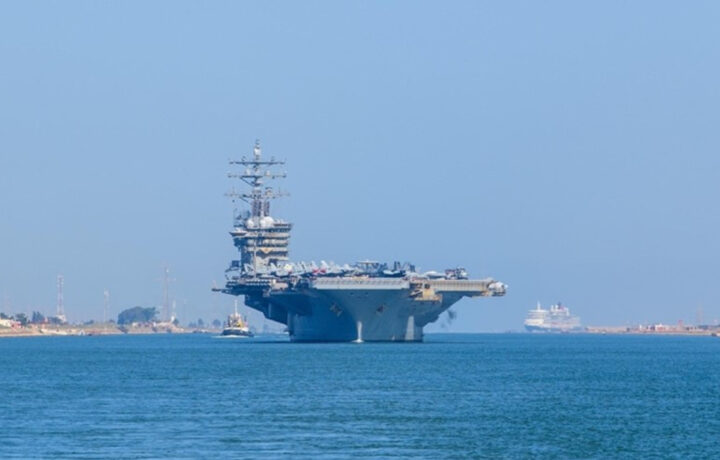Currently, the United States Navy has deployed two of its nuclear-powered aircraft carriers to the Middle East to help deter the war in Gaza from escalating. Last week, the Dwight D. Eisenhower Aircraft Carrier Strike Group (IKECSG) arrived in the Middle East as part of an increase in regional posture, after the Nimitz-class aircraft carrier USS Dwight D. Eisenhower (CVN-69) drilled for three days in the Mediterranean Sea with the first-in-class USS Gerald R. Ford (CVN-78) along with USS Mount Whitney (LCC-20) and two Italian guided-missile frigates.
“The arrival of IKECSG to Middle East region displays our speed and agility to flex as our nation’s leaders determined a balance of maritime capability in support of national security priorities,” said Rear Adm. Marc Miguez, commander, CSG-2, IKECSG. “The strike group brings an unparalleled combat superiority to CENTCOM (U.S. Central Command) and we will be leveraging our presence in the theater to enhance regional security and operate alongside our allies and partners.”
In addition, the U.S. Navy’s only forward-deployed aircraft carrier USS Ronald Reagan (CVN-76) arrived in Manila, Republic of the Philippines. Though its arrival in the Philippine capital was planned in advance and was not a response to the latest flare-up between Beijing and Manila, it further sent the message that the U.S. would help defend the Philippines in case of an armed attack following an incident that saw Chinese ships attempt a blockade and subsequently collided with two Filipino vessels near the contested Second Thomas Shoal in the South China Sea last month.
Two other Nimitz-class carriers, the USS George Washington (CVN-73) and USS John C. Stennis (CVN-74) are currently “out-of-service” at Naval Station Norfolk, Norfolk, Virginia – with the former completing her four-year Refueling and Complex Overhaul (RCOH) that began in August 2017. The latter vessel is next up for the scheduled RCOH, which will be completed sometime by the end of the decade.
Are the Navy’s Carriers Spread Too Thin?
All of the branches of the U.S. military have increasingly had to do more with less – but given that the U.S. Navy’s nuclear-powered carriers are meant to project power around the globe, it isn’t so clear that the 11 ships currently commissioned can adequately do the job.
That is why earlier this year, the Navy began to weigh if it would extend the life of CVN-69 past its planned 2027 inactivation date. It is now listed to depart the fleet only a year after USS Nimitz (CVN-68) as part of the service’s long-range shipbuilding plan, but naval officials have been considering whether it would be viable to squeeze another deployment out of the Ike before its planned inactivation.
The U.S. Navy’s fiscal 2023 budget has already called to extend the first-in-class CVN-68, commissioned in 1975, for another deployment cycle instead of decommissioning it in 2025 as previously planned. Such extensions may be necessary for all of the Nimitz-class flattops.
“Extending Nimitz, extending Ike, it’s going to happen for every Nimitz-class carrier. At least one extension,” Vice Adm. Kenneth Whitesell, then-commander of Naval Air Forces, said during an Aug. 25 discussion at the Tailhook Symposium shortly before he retired from the service.
The U.S. Navy will likely consider Nimitz-class carrier life extensions on a hull-by-hull basis.
Ford-class Running Behind Schedule
Extending the older carriers may be necessary as the U.S. Navy’s future carriers may be late in arriving. The USS Gerald R. Ford had been originally scheduled for delivery in 2015, only to be pushed back to May 2017. Her first deployment was only last fall.
Now, the second Ford-class aircraft carrier, the future USS John F. Kennedy (CVN-79) is fitting out, but won’t be commissioned until at least some time in 2025, which will be followed by lengthy sea trials. She is scheduled to replace CVN-68.
Given that the United States is still focused on the Middle East, as well as addressing threats from near-peer adversaries including China and Russia, it would seem the Navy needs every flattop it can get.
“Carriers are the linchpin of everything we do in naval aviation,” Director of Air Warfare (N98) Rear Adm. Michael Donnelly recently told Aviationweek.com. “Our requirements are designed and aligned within our air wings to provide the capability out to the [combatant commands] for our ability to conduct the mission. Our ability to get the carriers out on time, whether it is new procurement or maintenance, is essential.”
How to Retire a Nuclear-Powered Carrier?
Extending the service life of the Nimitz-class carriers could help address another issue – namely dismantling the warships.
As previously reported, it was estimated that dismantling the U.S. Navy’s first nuclear-powered carrier, USS Enterprise (CVN-65), could take at least five years and cost between $554 and $696 million at a commercial yard.
Another plan called for the dismantling to take upwards of 15 years and cost as much as $1.358 billion.
Part of the problem is that U.S. Navy shipyards are overworked, and can’t adequately address the maintenance for active warships – and there simply isn’t the capacity to take old nuclear-powered carriers apart.
This past spring, the U.S. Navy published a pre-solicitation notice announcing that Huntington Ingalls’ Newport News Shipbuilding division would formulate requirements for scrapping the USS Nimitz. Retiring the warships could end up being a costly endeavor. While extending their respective lives won’t really address that issue, it can at least delay it a bit.




